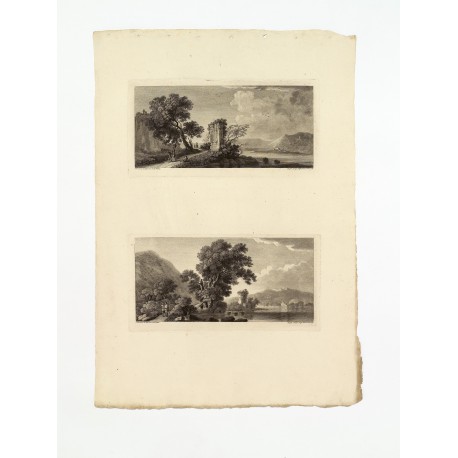Italian landscapes with figures
- Subjects
- Book illustration - Reproductive printmaking - Capo (Francesco Antonio de), active 1775-1800
- Prints - Artists, Italian - Cunego (Giuseppe), active 1781-1784
- Authors/Creators
- Capo, Francesco Antonio de, active 1775-1800
- Artists/Illustrators
- Capo, Francesco Antonio de, active 1775-1800
- Cunego, Giuseppe, active 1781-1784
Capo, Francesco Antonio de
fl. 1775 – 1800
Italian landscapes with figures
Rome, [publisher unknown], 1784
Four engravings (145 × 290 mm platemarks, imposed in pairs on two untrimmed sheets measuring 565 × 400 mm), with identical legend beneath each print Franciscus de Capo inv. et del. Romae | Joseph Cunego sculp. Romae anno 1784.
The untitled prints depict: (a) river landscape with five travelers on a road passing an antique tomb; (b) river landscape with two travelers on a path, a ruined tower behind; (c) river landscape with a single traveller on a road; (d) river landscape with four travelers (one on horseback, another in foreground seated).
paper watermarks (or countermarks) Bracciano (in a & b), crowned shield with a rampant leopard (in c & d), both marks observed in prints of Piranesi, often associated.1
provenance Christie’s, ‘Valuable manuscripts and printed books’, London, 24 November 1993, lot 77 — Olimpia Theodoli, ‘Landscape: Fine prints from circa 1525 to 1800’, London & Milan 1997, item 63
Superb impressions on almost untrimmed sheets.
A suite of four engravings of paesaggi italiani con figure after designs by Francesco Antonio de Capo, a painter born near Lecce in Apulia, documented in Naples and Rome from about 1775, where he associated with the Genoese landscape painter Giuseppe Bacigalupo. In the early 1780s, De Capo had worked as a stage designer in Perugia, and a number of his wash drawings and oil paintings were once concentrated in Perugian collections.2
Sheet dimensions 565 × 400 mm
Sheet dimensions 565 × 400 mm
A brush and brown wash drawing in Edinburgh of a ‘River landscape with ruined tower’ (125 × 280 mm), inscribed on its mount Francº Antonio de Capo. Roma 1784 appears to be the original from which Cunego engraved print (b) of this suite.3
The printmaker Giuseppe Cunego was born in Verona in 1760, the son and pupil of Domenico (1726–1823) and brother of Luigi Cunego. He followed his father to Rome, but soon abandoned art, and took up the religious life, becoming a lay brother of the Third Order of Minims. His engraved oeuvre is just fifteen prints: eleven engravings after Gaspard Dughet’s frescoes in the Palazzo Colonna in Rome, dated 1781 or 1782;4 and these four prints, each dated 1784.5 A later state of print (a) with added publication line In Roma: presso [Filippo] Piale Negoziante di Stampe e Carta a S. Carlo al Corso N.° 428 is known (Biblioteca Panizzi, Reggio Emilia).6
1. Andrew Robison, Piranesi. Early architectural fantasies (Chicago & London 1986), pp.227–228 nos. 59, 64.
2. Baldassare Orsini, Guida al forestiere per l’augusta Città di Perugia (Perugia 1784), p.89, records ‘Due paesi squisitamente acquerellati, ed inventati con gusto, e naturalezza’ and ‘Dieci pezzi dipinti a olio’. A wash drawing ‘Cascatelle di Tivoli’ with inscription on the mount ‘Francesco da Capo detto Ciccio’ is reproduced by Marco Chiarini, Vedute romane: disegni dal xvi al xviii secolo (Rome 1971), p.79 no. 101; a panorama of Rome, signed Capo fecit. Roma 1794, is reproduced by David Scrase, Italian Drawings at the Fitzwilliam Museum, Cambridge (Cambridge 2011), pp.169–170 no. 129.
3. National Gallery of Scotland, Catalogue of Italian Drawings, by Keith Andrews (Cambridge 1968), p.29, fig. 226a; David Laing Bequest to the Royal Scottish Academy on loan 1966, RSA 404 (collection database; link).
4. Marie-Nicole Boisclair, Gaspard Dughet 1615–1675 (Paris 1986), pp.352–353 nos. G33–43, figs. 585–591.
5. Karl Heinrich von Heinecken, Dictionnaire des artistes, dont nous avons des estampes (Leipzig 1789), iii, p.576 (‘Joseph Cunego a gravé quatre Paysages’); Charles Le Blanc, Manuel de l’amateur d’estampes (Paris 1856), ii, p.76 nos. 1–4.
6. Zeno Davoli, La Raccolta di Stampe ‘Angelo Davoli’. Catalogo generale (Reggio Emilia 1999), iii, no. 10018 (database; image).








